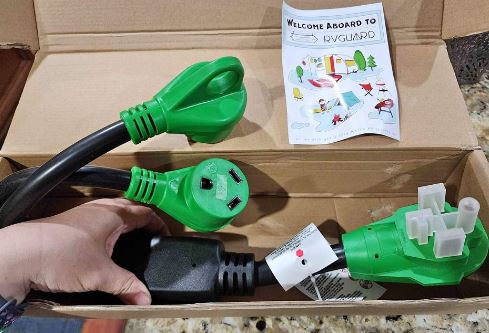Can I Plug My 50 Amp RV into a 30 Amp? Understanding RV Electrical Compatibility

Hey there, fellow RV enthusiasts! If you've ever found yourself wondering whether you can plug your 50 amp RV into a 30 amp outlet, you're not alone. It's a common question that arises when we're faced with different electrical setups on our journeys. Join me as we dive into the world of RV electrical compatibility, unraveling the mysteries behind the 30 amp versus 50 amp debate and learning how to navigate this tricky situation.
Understanding RV Electrical Systems
Before we get into the nitty-gritty, let's break down the basics of RV electrical systems. You see, RVs come with different electrical setups – the 30 amp and the 50 amp. These numbers represent the maximum amount of power the RV can draw from a power source. Understanding this is key to unraveling the plug dilemma.
The Limitations of a 30 Amp Outlet
Now, let's talk about that 30 amp outlet you might encounter at some campgrounds. It's crucial to understand that a 30 amp outlet has its limitations. While it's suitable for many RVs, it might not be enough to power all the appliances and systems in a 50 amp RV. Think air conditioning, heavy-duty appliances – these might not run smoothly on a 30 amp circuit.
Using an Adapter
There's a solution in the form of a 50 amp to 30 amp adapter. This nifty device allows you to connect your 50 amp RV to a 30 amp outlet. It's like a translator between different languages, ensuring your RV can communicate with the power source without any mishaps.
Managing Power Demand
Now, using an adapter is fantastic, but it comes with a caveat. You'll need to manage your power demand. With a 30 amp outlet, you need to be mindful of your energy consumption. Think energy-efficient appliances, managing your usage, and ensuring you don't overload the circuit and trip the breakers.
30-Amp and 50-Amp RV Service: The True Difference?
RVs come with different electrical service options to accommodate varying power needs. The two most common service types are 30-amp and 50-amp setups, each designed for specific RV sizes and appliance demands. Here's a breakdown of these service types: A 30 amp rv is able to handle 3,600 watts while a 50 amp Rv is able to handle 12,000 watts.
These calculations are as follows:
30 Amp Rv
Maximum Power (Watts) = Voltage (Volts) × Current (Amps)
Assuming a standard voltage of 120 volts: Maximum Power (Watts) = 120 V × 30 A = 3,600 Watts
50 Amp Rv
Maximum Power (Watts) = Voltage (Volts) × Current (Amps)
Assuming a standard voltage of 120 volts: Maximum Power (Watts) = (120 V × 50 A) X 2 = (6000 Watts) X 2 = 12,000 Watts.
We get 12,000 watts for 50 amps as there are two separate hot wires on a 50 amp plug or pedestal.
Potential Issues and Risks
Of course, it's important to acknowledge potential risks. Overloading a circuit might lead to overheating, damage to appliances, and even electrical hazards. Safety should always be a priority.
Steps to Safely Connect a 50 Amp RV to a 30 Amp Outlet
Here's a step-by-step guide to safely connect your 50 amp RV to a 30 amp outlet using an adapter:
- Make sure your RV is unplugged from any power source.
- Connect the adapter to the RV's power cord.
- Plug the adapter into the 30 amp outlet.
- Now, you're connected! But remember, be mindful of your power usage.
Recommended Practices and Precautions
To ensure a smooth experience, consider using energy-efficient appliances, turning off non-essential systems when using power-hungry ones, and maybe even investing in a surge protector for extra safety.
When to Seek Professional Assistance
If you're unsure about your RV's electrical setup or have concerns, don't hesitate to seek professional help. An electrician or an RV technician can provide guidance and ensure your setup is safe and sound.
Capabilities of a 50 amp RV and a 30 amp service
| Aspect |
50 Amp RV |
30 Amp Service |
| Power Capacity |
50 amps |
30 amps |
| Appliances Supported |
Full range |
Limited (list) |
| Overloading Risk |
Lower risk |
Higher risk |
| Potential Voltage Drops |
Less likely |
More likely |
Potential Risks
The potential issues that may arise when plugging a 50 amp RV into a 30 amp service.
| Issue |
Consequence |
| Overheating Wiring |
Fire hazard, damage to electrical system |
| Tripped Circuit Breakers |
Loss of power, inconvenience |
| Diminished Appliance Function |
Reduced performance of high-demand items |
| Voltage Fluctuations |
Damage to sensitive electronics |
Subscribe
Stay updated with our newsletter
Precautions and Solutions
| Precaution/Solution |
Description |
| Use Energy-Efficient Appliances |
Reduce power draw |
| Prioritize Essential Systems |
Run critical appliances sequentially |
| Invest in a Surge Protector |
Protect electronics from voltage spikes |
| Monitor Usage with an Amp Meter |
Stay within safe power limits |
Conclusion
So, can you plug your 50 amp RV into a 30 amp outlet? Yes, you can, with the right precautions and a handy adapter. Remember, knowledge is power – both literally and figuratively – when it comes to RV electrical compatibility. Happy RVing!
